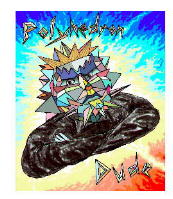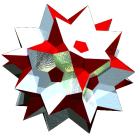As abstract polytope querco is isomorphic to sirco,
thereby replacing retrograde triangles by prograde ones.
– As such querco is a lieutenant.
Just as sirco allows for a gyrated stack, esquigybcu (J37), this quasi-version too
has an according gyrated stacking: rasquacu + inv stop + gyro rasquacu =
gyquerco. In fact, both have the same vertex figure all over. But querco features full cubical symmetry, while
gyquerco features 4-fold antiprismatic symmetry only, thereby dividing the according vertex set into 2 classes.
As such gyquerco then would be the quasi-variant of esquigybcu.
This polyhedron is an edge-faceting of the great cubicuboctahedron (gocco).
Incidence matrix according to Dynkin symbol
x3/2o4x
. . . | 24 | 2 2 | 1 2 1
--------+----+-------+-------
x . . | 2 | 24 * | 1 1 0
. . x | 2 | * 24 | 0 1 1
--------+----+-------+-------
x3/2o . | 3 | 3 0 | 8 * *
x . x | 4 | 2 2 | * 12 *
. o4x | 4 | 0 4 | * * 6
x4/3o3x
. . . | 24 | 2 2 | 1 2 1
--------+----+-------+-------
x . . | 2 | 24 * | 1 1 0
. . x | 2 | * 24 | 0 1 1
--------+----+-------+-------
x4/3o . | 4 | 4 0 | 6 * *
x . x | 4 | 2 2 | * 12 *
. o3x | 3 | 0 3 | * * 8



